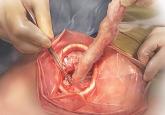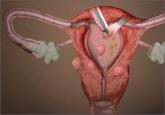Expert Commentary

46 experts pen open letter to the FDA on uterine power morcellation
An interview with Eva Chalas, MD

46 minimally invasive surgeons, gynecologic oncologists, and other experts send an open letter to the FDA calling into question its estimate of the likelihood of occult leiomyosarcoma and recommending continued use of power morcellation in appropriate cases
Click here to listen to an interview with letter signatory Eva Chalas, MD
In November 2014, the FDA ruled that power morcellation was contraindicated in "the majority of women" having surgery for uterine fibroids due to the potential risk of spreading occult uterine sarcoma. 1 Although problems with this ruling were immediately apparent, the passage of time has allowed for more clarity on the related medical issues.
Prevalence of leiomyosarcoma among women having surgery for presumed uterine fibroids
The prevalence of occult leiomyosarcoma among women with fibroids is critical for every patient. All medical procedures have potential risk and the patient's understanding of risk is the foundation of medical decision making.
The FDA estimated that for every 458 women having surgery for fibroids, one woman would be found to have an occult leiomyosarcoma (LMS). We challenge this calculation. To estimate this risk, the FDA searched medical databases using the terms “uterine cancer” AND “hysterectomy or myomectomy.” Because “uterine cancer” was required, studies where cancer was not found or discussed were not identified. Nine studies, all but one of which were retrospective, were analyzed including a non–peer-reviewed Letter to the Editor and an abstract from an unpublished study. 2,3
Additionally, 3 leiomyosarcoma cases identified by the FDA do not meet current pathologic criteria for cancer and would now be classified as benign "atypical" leiomyomas. If atypical leiomyomas and non–peer-reviewed data are excluded, the FDA identified 8 cases of LMS among 12,402 women having surgery for presumed leiomyomas, a prevalence of 1 in 1,550 (0.064%).
Pritts and colleagues 4 recently published a more rigorous meta-analysis of 133 studies and determined that the prevalence of LMS among women having surgery for presumed fibroids was 1 in 1,960, or 0.051%. All peer-reviewed reports in which surgery was performed for presumed fibroids were analyzed, including reports where cancer was not found. Inclusion criteria required that histopathology results be explicitly provided and available for interpretation. Among the 26 randomized controlled trials analyzed, 1,582 women had surgery for fibroids and none were found to have LMS.
Bojahr and colleagues 5 recently published a large population-based prospective registry study and reported 2 occult LMS among 8,720 women having surgery for fibroids (0.023%).
In summary: The re-analyzed FDA dataset yields a prevalence of 1 in 1,550 (0.064%); the Pritts study reports a prevalence of 1 in 1,960 (0.051%), with the RCTs having a prevalence of 0; and the Bojahr study reports a prevalence of 2 of 8,720 (0.023%). We acknowledge that with rare events statistical analysis may be uncertain and confidence intervals may be wide. However, these numbers do not support the FDA's estimated prevalence of LMS among women having surgery for presumed fibroids and those at risk for morcellation of an LMS.
Prognosis for women with morcellated LMS
Women with LMS, removed intact without morcellation, have a poor prognosis. Based on SEER data, the 5-year survival of stage I and II LMS is only 61%. 6 Whether morcellation influences the prognosis of women with LMS is not known, and the biology of this tumor has not been well studied. Distant metastases occur early in the disease process, primarily hematogenous dissemination. Four frequently quoted published studies examine survival following power morcellation. Surprisingly, virtually none of the women in these studies had power morcellation. Furthermore, the data presented in these reports are poorly analyzed and patient numbers are very small.
Park and colleagues 7 reported only one of the 25 morcellated cases had laparoscopic surgery with power morcellation. Eighteen women had a laparoscopically-assisted vaginal hysterectomy with scalpel morcellation performed through the vagina, one had a vaginal hysterectomy with scalpel-morcellation, and 5 had mini-laparotomy with scalpel morcellation through small lower abdominal incisions. Seventeen of the 25 patients plotted in the published survival curve were referred to the hospital after initial diagnosis or the discovery of a recurrence at another institution. Since the number of nonreferred women with less aggressive disease or without recurrence is not known, it is not possible to determine differences in survival between patients with and without morcellation.
In a study by Perri and colleagues, 8 none of the patients had power morcellation: 4 women had abdominal myomectomy; 4 had hysteroscopic myomectomy with tissue confined within the uterine cavity; 2 had laparoscopic hysterectomy with scalpel morcellation; 4 had supracervical abdominal hysterectomy with cut-through at the cervix; and 2 had abdominal hysterectomy with injury to the uterus with a sharp instrument.
When comparing the outcomes for women with morcellated and nonmorcellated LMS, Morice and colleagues 9 found no difference in recurrence rates or overall and disease-free survival at 6 months.
In the only study to compare use of power with scalpel morcellation in women with LMS, Oduyebo and colleagues 10 found no difference in outcomes for the 10 women with power morcellation and 5 with scalpel morcellation followed for a median of 27 months (range, 2–93 months). Notably, a life table analysis of the above studies showed no difference in survival between morcellation methods. 11
Of note, laparoscopic-aided morcellation allows the surgeon to inspect the pelvic and abdominal cavities and irrigate and remove tissue fragments under visual control. In contrast, the surgeon cannot visually inspect the peritoneal cavity during vaginal or mini-laparotomy procedures. Morcellation within containment bags has recently been utilized in an attempt to avoid spread of tissue. This method has not yet been proven effective or safe, and there is concern that bags may make morcellation more cumbersome and less safe.
What the FDA restrictions mean for women
The FDA communication states, "the FDA is warning against the use of laparoscopic power morcellators in the majority of women undergoing hysterectomy or myomectomy for uterine fibroids." 1 This statement is not consistent with current evidence.
Moreover, a severe restriction of morcellation, including vaginal and mini-laparotomy morcellation, would limit women with symptomatic leiomyomas to one option: total abdominal hysterectomy. For women with fibroids larger than a 10-week pregnancy size, which most often require either scalpel or power morcellation in order to remove tissue, a ban on morcellation would eliminate the following procedures:
If abdominal hysterectomy is recommended to women with fibroids, will women be better off?
By focusing exclusively on the risk of LMS, the FDA failed to take into account other risks associated with surgery. Laparoscopic surgery uses small incisions, is performed as an outpatient procedure (or overnight stay), has a faster recovery (2 weeks vs 4–6 weeks for open surgery), and is associated with lower mortality and fewer complications. These benefits of minimally invasive surgery are now well established in gynecologic and general surgery.
Using published best-evidence data, a recent decision analysis 12 showed that, comparing 100,000 women undergoing laparoscopic hysterectomy with 100,000 undergoing open hysterectomy, the group undergoing laparoscopic surgery would experience 20 fewer perioperative deaths, 150 fewer pulmonary or venous embolus, and 4,800 fewer wound infections. Importantly, women having open surgery would have 8,000 fewer quality-of-life years.
A recently published study 13 found that, in the 8 months following the FDA safety communication, utilization of laparoscopic hysterectomies decreased by 4.1% ( P = .005), and abdominal and vaginal hysterectomies increased by 1.7% ( P = .112) and 2.4% ( P = .012), respectively. Major surgical complications (not including blood transfusions) increased from 2.2% to 2.8% ( P = .015), and the rate of hospital readmission within 30 days also increased from 3.4% to 4.2% ( P = .025). These observations merit consideration as women weigh the pros and cons of minimally invasive surgery with morcellation versus open surgery. These observations merit consideration as women weigh the pros and cons of minimally invasive surgery with possible morcellation versus open surgery.
Clinical recommendations
Recent attention to surgical options for women with uterine leiomyomas and the risk of an occult leiomyosarcoma are positive developments in that the gynecologic community is re-examining relevant issues. We respectfully suggest that the following clinical recommendations be considered:
Respecting women who suffer from leiomyosarcoma, we conclude that the FDA directive was based on a misleading analysis. Consequently, more accurate estimates regarding the prevalence of LMS among women having surgery for fibroids should be issued. Women have a right to self determination. Modification of the FDA's current restrictive guidance regarding power morcellation would empower each woman to consider the pertinent issues and have the freedom to undertake shared decision making with her surgeon in order to select the procedure that is most appropriate for her.
William Parker, MD
Clinical Professor, University of California Los Angeles (UCLA) School of Medicine, Director, Minimally Invasive Gynecologic Surgery, Santa Monica-UCLA Medical Center, Santa Monica, California
Jonathan S. Berek, MD, MMS
Laurie Kraus Lacob Professor and Director, Stanford Women's Cancer Center, Director, Stanford Health Care Communication Program, Chair, Department of Obstetrics and Gynecology, Stanford University School of Medicine, Stanford, California
Elizabeth Pritts, MD
Wisconsin Fertility Institute, Middleton, Wisconsin
David Olive, MD
Wisconsin Fertility Institute, Middleton, Wisconsin
Andrew M. Kaunitz, MD
University of Florida Research Foundation Professor and Associate Chairman, Department of Obstetrics and Gynecology, University of Florida College of Medicine–Jacksonville; Director, Menopause and Gynecologic Ultrasound Services, UF Women’s Health Specialists at Emerson, Jacksonville, Florida.
Eva Chalas, MD
Chief, Division of Gynecologic Oncology, Director, Clinical Cancer Services, Vice-Chair, Department of Obstetrics and Gynecology, Winthrop-University Hospital, Mineola, New York
Daniel Clarke-Pearson, MD
Professor and Chair, Clinical Research, Gynecologic Oncology Program, University of North Carolina at Chapel Hill
Barbara Goff, MD
Professor, Obstetrics and Gynecology, Director, Division of Gynecologic Oncology, University of Washington, Seattle, Washington
Robert E. Bristow, MD, MBA
Professor and Chair, Department of Obstetrics and Gynecology, University of California Irvine School of Medicine, Orange, California
Hugh S. Taylor, MD
Anita O'Keeffe Young Professor and Chair, Department of Obstetrics, Gynecology, and Reproductive Sciences, Yale School of Medicin; Chief of Obstetrics and Gynecology, Yale-New Haven Hospital, New Haven, Connecticut
Robin Farias-Eisner, MD
Chief, Gynecology and Gynecologic Oncology, Department of Obstetrics and Gynecology, David Geffen School of Medicine at University of California Los Angeles
Amanda Nickles Fader, MD
Director, Kelly Gynecologic Oncology Service, Associate Professor of Gynecology and Obstetrics, Director, FJ Montz Fellowship in Gynecologic Oncology, Johns Hopkins Medicine, Baltimore, Maryland
G. Larry Maxwell, MD, COL (ret) US Army
Chairman, Department of Obstetrics and Gynecology, Inova Fairfax Hospital, Falls Church, Virginia; Co-Investigator and Deputy Director of Science, Department of Defense Gynecologic Cancer Translational Research Center of Excellence, Bethesda, Maryland; Professor of Virginia Commonwealth School of Medicine, Richmond, Virginia; and Executive Director of Globeathon to End Women’s Cancer
Scott C. Goodwin, MD
Hasso Brothers Professor and Chairman, Radiological Sciences, University of California Irvine Medical Center, Orange, California
Susan Love, MD, MBA
Dr. Susan Love Research Foundation, Encino, California
William E. Gibbons, MD
Professor and Director, Division of Reproductive Medicine, Director of Fellowship Training, Department of Obstetrics and Gynecology, Baylor College of Medicine; Chief of Reproductive Medicine at the Pavilion For Women at Texas Children’s Hospital, Houston, Texas
Leland J. Foshag, MD
Surgical Oncology, Melanoma and Sarcoma, John Wayne Cancer Institute, Santa Monica, California
Phyllis C. Leppert, MD, PhD
Emerita Professor of Obstetrics and Gynecology, Duke University School of Medicine; President of The Campion Fund, Phyllis and Mark Leppert Foundation for Fertility Research, Durham, North Carolina
Judy Norsigian
Co-founder of Our Bodies, Ourselves, Boston, Massachusetts
Charles W. Nager, MD
Professor and Chairman, Department of Reproductive Medicine, University of California San Diego Health System
Timothy Robert B. Johnson, MD
Arthur F. Thurnau Professor and Chair, Department of Obstetrics and Gynecology, Professor of Women’s Studies, and Research Professor in the Center for Human Growth and Development, University of Michigan, Ann Arbor, Michigan
David S. Guzick, MD, PhD
Senior Vice President of Health Affairs, President of UF Health, University of Florida, Gainesville, Florida
Sawsan As-Sanie, MD, MPH
Assistant Professor and Director, Minimally Invasive Gynecologic Surgery, Fellowship Director of Endometriosis Center, University of Michigan, Ann Arbor, Michigan
Richard J. Paulson, MD
Alia Tutor Chair in Reproductive Medicine, Professor and Vice-Chair, Department of Obstetrics and Gynecology, Chief, Division of Reproductive Endocrinology and Infertility, Keck School of Medicine, University of Southern California, Los Angeles, California
Cindy Farquhar
Professor of Obstetrics and Gynaecology and National Women's Health, University of Auckland, New Zealand
Linda Bradley, MD
Vice Chair of Obstetrics, Gynecology, and Women’s Health Institute, Director of the Fibroid and Menstrual Disorders Center, Department of Obstetrics and Gynecology, Cleveland Clinic, Cleveland, Ohio.
Stacey A. Scheib, MD
Assistant Professor and Director, Hopkins Multidisciplinary Fibroid Center, Director of Minimally Invasive Gynecologic Surgery, Johns Hopkins Hospital, Baltimore, Maryland
Anton J. Bilchik, MD, PhD
Professor of Surgery, Chief of Medicine at John Wayne Cancer Institute, Santa Monica, California
Laurel W. Rice, MD
Chair, Department of Obstetrics and Gynecology, Professor, Division of Gynecology Oncology, University of Wisconsin-Madison School of Medicine and Public Health, Madison, Wisconsin
Carla Dionne
Founder of National Uterine Fibroid Foundation, Colorado Springs, Colorado
Alison Jacoby, MD
Director, University of California-San Francisco Comprehensive Fibroid Center, Interim Chief, Division of Gynecology, University of California San Francisco
Charles Ascher-Walsh, MD
Director of Gynecology, Urogynecology, and Minimally Invasive Surgery, Mt. Sinai School of Medicine, New York, New York
Sarah J. Kilpatrick, MD, PhD
Chair of Department of Obstetrics and Gynecology, Associate Dean of Faculty Development, Helping Hand of Los Angeles Chair in Obstetrics and Gynecology, Cedars-Sinai Medical Center, Los Angeles, California
G. David Adamson, MD
Clinical Professor, Stanford University School of Medicine, Stanford, California; Past President of the American Society for Reproductive Medicine
Matthew Siedhoff, MD, MSCR
Assistant Professor and Division Director, Minimally Invasive Gynecologic Surgery, Department of Obstetrics and Gynecology, University of North Carolina at Chapel Hill
Robert Israel, MD
Professor, Department of Obstetrics and Gynecology, Chair, Quality Improvement, Director, Women's Health Clinics and Referrals, LAC+USC Medical Center, Los Angeles, California
Marie Fidela Paraiso, MD
Head, Female Pelvic Medicine & Reconstructive Surgery, Department of Obstetrics and Gynecology, Cleveland Clinic, Cleveland, Ohio
Michael M. Frumovitz, MD, MPH
Fellowship Program Director, Department of Gynecologic Oncology and Reproductive Medicine, University of Texas MD Anderson Cancer Center, Houston, Texas
John R. Lurain, MD
Marcia Stenn Professor of Gynecologic Oncology, Program Director, Fellowship in Gynecologic Oncology, Northwestern University Feinberg School of Medicine, Chicago, Illinois
Ayman Al-Hendy, MD, PhD
Georgia Regents University Director of Interdisciplinary Translational Research; Medical College of Georgia Assistant Dean for Global Translational Research; Professor and Director, Division of Translational Research, Department of Obstetrics and Gynecology, Georgia Regents Health, Augusta, Georgia
Guy I. Benrubi, MD
Senior Associate Dean for Faculty Affairs, Robert J. Thompson Professor and Chair of Department of Obstetrics and Gynecology, University of Florida College of Medicine – Jacksonville
Steven S. Raman, MD
Professor, Radiology, Urology, and Surgery, Co-director, Fibroid Treatment Program, David Geffen School of Medicine at University of California Los Angeles
Rosanne M. Kho, MD
Associate Professor and Head, Section of Urogynecology and Female Pelvic Medicine & Reconstructive Surgery; Co-Director of Minimally Invasive Gynecologic Surgery Fellowship Program, Columbia University Medical Center, New York, New York
Ted L. Anderson, MD, PhD
Betty and Lonnie S. Burnett Professor and Chair, Obstetrics and Gynecology, Division Director of Gynecology, Vanderbilt University School of Medicine, Nashville, Tennessee
R. Kevin Reynolds, MD
The George W. Morley Professor and Chief, Division of Gynecologic Oncology, University of Michigan Health System, Ann Arbor, Michigan
John DeLancey, MD
Norman F. Miller Professor of Obstetrics & Gynecology, University of Michigan Health System, Ann Arbor, Michigan

An interview with Eva Chalas, MD

Dr. William Parker discusses the FDA's estimate of the incidence of occult uterine malignancy at the time of benign hysterectomy and explains why...

Use beef tongue, a cardboard box, and a homemade self-retaining wound retractor to teach or perfect your extracorporeal C-incision tissue...

Open power morcellation now is contraindicated in perimenopausal and postmenopausal women. What is Johns Hopkins’ protocol in this new climate? An...
